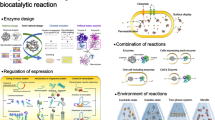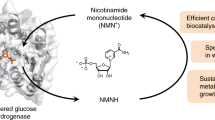Abstract
Noncanonical redox cofactor systems utilize nicotinamide adenine dinucleotide (phosphate), NAD(P)H, mimics to perform biotransformation reactions. Compared to systems utilizing native NAD(P)H, these noncanonical redox cofactors can offer decreased cost of cofactor supply, improved system activities, and can even supply reducing power directly to targeted reactions in complex biological environments. When these systems are operated in cell-free settings, the high level of user control afforded by direct access to the reaction system enables specific tuning of cofactor parameters, enzyme activity, and reaction progression to maximize system productivity. In this chapter, we will describe methods for constructing these cell-free noncanonical redox cofactor systems. Specifically, methods, design concepts, and system adaptation will be discussed for applying noncanonical redox cofactors to both purified protein-based and crude lysate-based biotransformation systems.
Access this chapter
Tax calculation will be finalised at checkout
Purchases are for personal use only
Similar content being viewed by others
References
Paul CE, Gargiulo S, Opperman DJ, Lavandera I, Gotor-Fernández V, Gotor V, Taglieber A, Arends IWCE, Hollmann F (2013) Mimicking nature: synthetic nicotinamide cofactors for C=C bioreduction using enoate reductases. Org Lett 15(1):180–183. https://doi.org/10.1021/ol303240a
Okamoto Y, Köhler V, Paul CE, Hollmann F, Ward TR (2016) Efficient in situ regeneration of NADH mimics by an artificial metalloenzyme. ACS Catal 6(6):3553–3557. https://doi.org/10.1021/acscatal.6b00258
Black WB, Zhang L, Mak WS, Maxel S, Cui Y, King E, Fong B, Sanchez Martinez A, Siegel JB, Li H (2020) Engineering a nicotinamide mononucleotide redox cofactor system for biocatalysis. Nat Chem Biol 16:87–94. https://doi.org/10.1038/s41589-019-0402-7
Richardson KN, Black WB, Li H (2020) Aldehyde production in crude lysate- and whole cell-based biotransformation using a noncanonical redox cofactor system. ACS Catal 10(15):8898–8903. https://doi.org/10.1021/acscatal.0c03070
Knaus T, Paul CE, Levy CW, de Vries S, Mutti FG, Hollmann F, Scrutton NS (2016) Better than nature: nicotinamide biomimetics that outperform natural coenzymes. J Am Chem Soc 138(3):1033–1039. https://doi.org/10.1021/jacs.5b12252
Wang L, Ji D, Liu Y, Wang Q, Wang X, Zhou YJ, Zhang Y, Liu W, Zhao ZK (2017) Synthetic cofactor-linked metabolic circuits for selective energy transfer. ACS Catal 7:1977–1983. https://doi.org/10.1021/acscatal.6b03579
Rollin JA, Tam TK, Zhang YHP (2013) New biotechnology paradigm: cell-free biosystems for biomanufacturing. Green Chem 15:1708–1719. https://doi.org/10.1039/c3gc40625c
Paul CE, Arends IWCE, Hollmann F (2014) Is simpler better? Synthetic nicotinamide cofactor analogues for redox chemistry. ACS Catal 4:788–797. https://doi.org/10.1021/cs4011056
Campbell EMM, Minteer SD, Banta S (2012) Enzymatic biofuel cells utilizing a biomimetic cofactor. Chem Commun 48:1898–1900. https://doi.org/10.1039/c2cc16156g
Knox RJ, Friedlos F, Jarman M, Davies LC, Goddard P, Anlezark GM, Melton RG, Sherwood RF (1995) Virtual cofactors for an Escherichia coli nitroreductase enzyme: relevance to reductively activated prodrugs in antibody directed enzyme prodrug therapy (ADEPT). Biochem Pharmacol 49(11):1641–1647. https://doi.org/10.1016/0006-2952(95)00077-d
Guo X, Liu Y, Wang Q, Wang X, Li Q, Liu W, Zhao ZK (2020) Non-natural cofactor and formate-driven reductive carboxylation of pyruvate. Angew Chem Int Ed 59:3143–3146. https://doi.org/10.1002/anie.201915303
Zachos I, Nowak C, Sieber V (2019) Biomimetic cofactors and methods for their recycling. Curr Opin Chem Biol 49:59–66. https://doi.org/10.1016/j.cbpa.2018.10.003
Lo CH, Ryan JD, Kerr JB, Clark DS, Fish RH (2017) Bioorganometallic chemistry: co-factor regeneration, enzyme recognition of biomimetic 1,4-NADH analogs, and organic synthesis; tandem catalyzed regioselective formation of N-substituted-1,4-dihydronicotinamide derivatives with [Cp*Rh(bpy)H]+, coupled to chiral S-alcohol formation with HLADH, and engineered cytochrome P450s, for selective C-H oxidation reactions. J Organomet Chem 839:38–52. https://doi.org/10.1016/j.jorganchem.2017.02.013
Huang R, Chen H, Upp DM, Lewis JC, Zhang YHP (2019) A high-throughput method for directed evolution of NAD(P)+-dependent dehydrogenases for the reduction of biomimetic nicotinamide analogues. ACS Catal 9(12):11709–11719. https://doi.org/10.1021/acscatal.9b03840
Guo X, Wang X, Liu Y, Li Q, Wang J, Liu W, Zhao ZK (2020) Structure-guided design of formate dehydrogenase for regeneration of a non-natural redox cofactor. Chem Eur J 26(70):16611–16615. https://doi.org/10.1002/chem.202003102
Ryan J, Fish R, Clark D (2008) Engineering cytochrome P450 enzymes for improved activity towards biomimetic 1,4-NADH cofactors. Chembiochem 9(16):2579–2582. https://doi.org/10.1002/cbic.200800246
Nowak C, Pick A, Lommes P, Sieber V (2017) Enzymatic reduction of nicotinamide biomimetic cofactors using an engineered glucose dehydrogenase: providing a regeneration system for artificial cofactors. ACS Catal 7(8):5202–5208. https://doi.org/10.1021/acscatal.7b00721
Nowak C, Pick A, Csepi L, Sieber V (2017) Characterization of biomimetic cofactors according to stability, redox potentials, and enzymatic conversion by NADH oxidase from Lactobacillus pentosus. Chembiochem 18:1944–1949. https://doi.org/10.1002/cibc.201700258
Guarneri A, Westphal A, Leertouwer J, Lunsonga J, Franssen M, Opperman D, Hollmann F, van Berkel W, Paul C (2020) Flavoenzmye-mediated regioselective aromatic hydroxylation with coenzyme biomimetics. ChemCatChem 12:1368–1375. https://doi.org/10.1002/cctc.201902044
Sicsic S, Durand P, Langrene S, le Goffic F (1984) A new approach for using cofactor dependent enzymes: example of alcohol dehydrogenase. FEBS Lett 176:321–324. https://doi.org/10.1016/0014-5793(84)81188-6
Eggerichs D, Mügge C, Mayweg J, Apfel U, Tischler D (2020) Enantioselective epoxidation by flavoprotein monooxygenases supported by organic solvents. Catalysts 10(5):568. https://doi.org/10.3390/catal10050568
Lutz J, Hollmann F, Ho T, Schnyder A, Fish R, Schmid A (2004) Bioorganometallic chemistry: biocatalytic oxidation reactions with biomimetic NAD+/NADH co-factors and [Cp*Rh(bpy)H]+ for selective organic synthesis. J Organomet Chem 689:4783–4790. https://doi.org/10.1016/j.organchem.2004.09.044
Qi J, Paul C, Hollmann F, Tischler D (2017) Changing the electron donor improves azoreductase dye degrading activity at neutral pH. Enzym Microb Technol 100:7–19. https://doi.org/10.1016/j.enzmictec.2017.02.003
Löw S, Löw L, Weissenborn M, Hauer B (2016) Enhanced ene-reductase activity through alteration of artificial nicotinamide cofactor substituents. ChemCatChem 8:911–915. https://doi.org/10.1002/cctc/201501230
Tischler D, Gädke E, Eggerichs D, Gomez Baraibar A, Mügge C, Scholtissek A, Paul C (2020) Asymmetric reduction of (R)-carvone through a thermostable and organic-solvent-tolerant ene-reductase. Chembiochem 21:1217–1225. https://doi.org/10.1002/cibc.201900599
Ji D, Wang L, Hou S, Liu W, Wang J, Wang Q, Zhao Z (2011) Creation of bioorthogonal redox systems depending on nicotinamide flucytosine dinucleotide. J Am Chem Soc 133:20857–20862. https://doi.org/10.1021/ja2074032
Liu Y, Li Q, Wang L, Guo X, Wang J, Wang Q, Zhao ZK (2020) Engineering d-lactate dehydrogenase to favor an non-natural cofactor nicotinamide cytosine dinucleotide. Chembiochem 21:1972–1975. https://doi.org/10.1002/cibc.201900766
Liu Y, Feng Y, Wang L, Guo X, Liu W, Li Q, Wang X, Xue S, Zhao Z (2019) Structural insights into phosphite dehydrogenase variants favoring a non-natural redox cofactor. ACS Catal 9:1883–1887. https://doi.org/10.1021/acscatal.8b04822
Lo HC, Fish RH (2002) Biomimetic NAD+ models for tandem cofactor regeneration, horse liver alcohol dehydrogenase recognition of 1,4-NADH derivatives, and chiral synthesis. Angew Chem 114(3):496–499. https://doi.org/10.1002/1521-3773(20020201)41:3<478::AID-ANIE478>3.0.CO;2-K
Author information
Authors and Affiliations
Corresponding author
Editor information
Editors and Affiliations
Rights and permissions
Copyright information
© 2022 The Author(s), under exclusive license to Springer Science+Business Media, LLC, part of Springer Nature
About this protocol
Cite this protocol
Black, W.B., Li, H. (2022). Cell-Free Noncanonical Redox Cofactor Systems. In: Karim, A.S., Jewett, M.C. (eds) Cell-Free Gene Expression. Methods in Molecular Biology, vol 2433. Humana, New York, NY. https://doi.org/10.1007/978-1-0716-1998-8_11
Download citation
DOI: https://doi.org/10.1007/978-1-0716-1998-8_11
Published:
Publisher Name: Humana, New York, NY
Print ISBN: 978-1-0716-1997-1
Online ISBN: 978-1-0716-1998-8
eBook Packages: Springer Protocols




